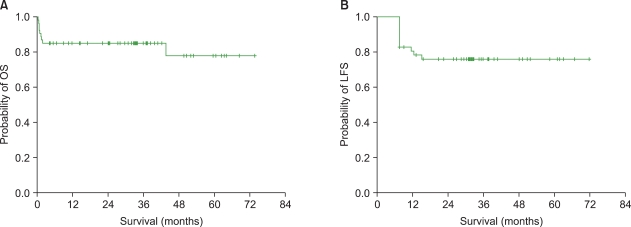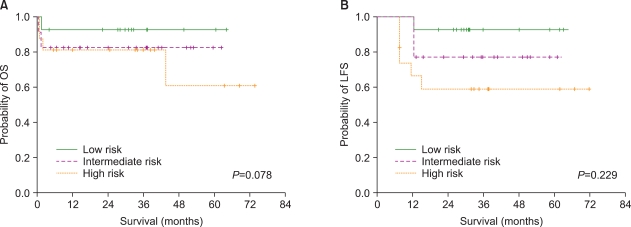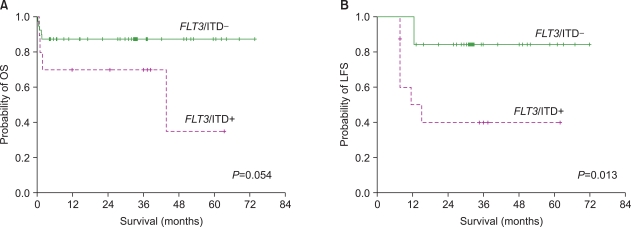Korean J Hematol.
2011 Mar;46(1):24-30. 10.5045/kjh.2011.46.1.24.
Treatment outcome of all-trans retinoic acid/anthracycline combination chemotherapy and the prognostic impact of FLT3/ITD mutation in acute promyelocytic leukemia patients
- Affiliations
-
- 1Department of Internal Medicine, Chonnam National University Medical School, Gwangju, Korea. hjoonk@jnu.ac.kr
- 2Genome Research Center for Hematopoietic Diseases, Chonnam National University Hwasun Hospital, Hwasun, Korea.
- 3Department of Hematology/Oncology, Korea University Anam Hospital, Seoul, Korea.
- 4Department of Laboratory Medicine, Chonnam National University Medical School, Gwangju, Korea.
- KMID: 2252015
- DOI: http://doi.org/10.5045/kjh.2011.46.1.24
Abstract
- BACKGROUND
All-trans retinoic acid (ATRA)/anthracycline chemotherapy is beneficial in newly diagnosed acute promyelocytic leukemia (APL); however, it is important to identify patients with high-risk disease to increase the cure rate. We investigated the outcome of ATRA/anthracycline chemotherapy and clinicobiological correlations of FLT3/ITD and NPM1 mutations in APL patients.
METHODS
Induction therapy included oral ATRA (45 mg/m2/day) and idarubicin (12 mg/m2/day, intravenous, on days 2, 4, and 6). Patients achieving complete remission (CR) received 3 courses of ATRA combined with reinforced consolidation therapy. Mutations were analyzed using GeneScan and polymerasae chain reaction assays of bone marrow samples obtained from patients at diagnosis.
RESULTS
Forty-five (84.9%) of 53 eligible patients achieved CR. The overall relapse rate was 8.9%, and the 3-year overall survival (OS) and leukemia-free survival (LFS) were 84.9+/-4.9% and 77.5+/-6.0%, respectively. The NPM1 mutation was not found in any patient, while the FLT3/ITD mutation was found in 10 (20.0%) patients. Of the FLT3/ITD+ patients, 80% belonged to the high-risk group, defined according to the presenting WBC and platelet counts. Among the patients who achieved CR, those who were FLT3/ITD+ had a higher relapse rate than those FLT3/ITD-. FLT3/ITD+ patients also had a significantly lower 3-year LFS than FLT3/ITD- patients. Multivariate analysis of the LFS showed that the FLT3/ITD mutation was independently associated with a shorter overall LFS, after adjusting for pretreatment risk stratification.
CONCLUSION
This study investigated the clinical outcome of newly diagnosed APL patients treated with ATRA/anthracycline chemotherapy. Patients carrying the FLT3/ITD mutation had more aggressive clinical features and a poorer clinical outcome.
Keyword
MeSH Terms
Figure
Reference
-
1. Fenaux P, Chastang C, Chevret S, et al. A randomized comparison of all transretinoic acid (ATRA) followed by chemotherapy and ATRA plus chemotherapy and the role of maintenance therapy in newly diagnosed acute promyelocytic leukemia. Blood. 1999; 94:1192–1200. PMID: 10438706.
Article2. Wang ZY, Chen Z. Acute promyelocytic leukemia: from highly fatal to highly curable. Blood. 2008; 111:2505–2515. PMID: 18299451.
Article3. Mistry AR, Pedersen EW, Solomon E, Grimwade D. The molecular pathogenesis of acute promyelocytic leukaemia: implications for the clinical management of the disease. Blood Rev. 2003; 17:71–97. PMID: 12642121.
Article4. Burnett AK, Grimwade D, Solomon E, Wheatley K, Goldstone AH. Presenting white blood cell count and kinetics of molecular remission predict prognosis in acute promyelocytic leukemia treated with all-trans retinoic acid: result of the randomized MRC trial. Blood. 1999; 93:4131–4143. PMID: 10361110.
Article5. Sanz MA, Lo Coco F, Martín G, et al. Definition of relapse risk and role of nonanthracycline drugs for consolidation in patients with acute promyelocytic leukemia: a joint study of the PETHEMA and GIMEMA cooperative groups. Blood. 2000; 96:1247–1253. PMID: 10942364.6. Sanz MA, Martín G, González M, et al. Risk-adapted treatment of acute promyelocytic leukemia with all-trans-retinoic acid and anthracycline monochemotherapy: a multicenter study by the PETHEMA group. Blood. 2004; 103:1237–1243. PMID: 14576047.
Article7. Adés L, Sanz MA, Chevret S, et al. Treatment of newly diagnosed acute promyelocytic leukemia (APL): a comparison of French-Belgian-Swiss and PETHEMA results. Blood. 2008; 111:1078–1084. PMID: 17975017.8. Rosnet O, Schiff C, Pébusque MJ, et al. Human FLT3/FLK2 gene: cDNA cloning and expression in hematopoietic cells. Blood. 1993; 82:1110–1119. PMID: 8394751.
Article9. Kottaridis PD, Gale RE, Frew ME, et al. The presence of a FLT3 internal tandem duplication in patients with acute myeloid leukemia (AML) adds important prognostic information to cytogenetic risk group and response to the first cycle of chemotherapy: analysis of 854 patients from the United Kingdom Medical Research Council AML 10 and 12 trials. Blood. 2001; 98:1752–1759. PMID: 11535508.
Article10. Gale RE, Green C, Allen C, et al. The impact of FLT3 internal tandem duplication mutant level, number, size, and interaction with NPM1 mutations in a large cohort of young adult patients with acute myeloid leukemia. Blood. 2008; 111:2776–2784. PMID: 17957027.
Article11. Colovic N, Tosic N, Aveic S, et al. Importance of early detection and follow-up of FLT3 mutations in patients with acute myeloid leukemia. Ann Hematol. 2007; 86:741–747. PMID: 17579862.
Article12. Kang HJ, Lee JW, Kho SH, et al. High transcript level of FLT3 associated with high risk of relapse in pediatric acute myeloid leukemia. J Korean Med Sci. 2010; 25:841–845. PMID: 20514303.
Article13. Chou WC, Hou HA, Liu CY, et al. Sensitive measurement of quantity dynamics of FLT3 internal tandem duplication at early time points provides prognostic information. Ann Oncol. 2011; 22:696–704. PMID: 20693296.
Article14. Kainz B, Heintel D, Marculescu R, et al. Variable prognostic value of FLT3 internal tandem duplications in patients with de novo AML and a normal karyotype, t(15;17), t(8;21) or inv(16). Hematol J. 2002; 3:283–289. PMID: 12522450.
Article15. Moreno I, Martín G, Bolufer P, et al. Incidence and prognostic value of FLT3 internal tandem duplication and D835 mutations in acute myeloid leukemia. Haematologica. 2003; 88:19–24. PMID: 12551822.16. Chillón MC, Fernández C, García-Sanz R, et al. FLT3-activating mutations are associated with poor prognostic features in AML at diagnosis but they are not an independent prognostic factor. Hematol J. 2004; 5:239–246. PMID: 15167911.
Article17. Falini B, Mecucci C, Tiacci E, et al. Cytoplasmic nucleophosmin in acute myelogenous leukemia with a normal karyotype. N Engl J Med. 2005; 352:254–266. PMID: 15659725.
Article18. Chen W, Rassidakis GZ, Medeiros LJ. Nucleophosmin gene mutations in acute myeloid leukemia. Arch Pathol Lab Med. 2006; 130:1687–1692. PMID: 17076533.
Article19. Thiede C, Koch S, Creutzig E, et al. Prevalence and prognostic impact of NPM1 mutations in 1485 adult patients with acute myeloid leukemia (AML). Blood. 2006; 107:4011–4020. PMID: 16455956.
Article20. Sanz MA, Martín G, Rayón C, et al. A modified AIDA protocol with anthracycline-based consolidation results in high antileukemic efficacy and reduced toxicity in newly diagnosed PML/RARalpha-positive acute promyelocytic leukemia. Blood. 1999; 94:3015–3021. PMID: 10556184.21. Cheson BD, Bennett JM, Kopecky KJ, et al. Revised recommendations of the International Working Group for diagnosis, standardization of response criteria, treatment outcomes, and reporting standards for therapeutic trials in acute myeloid leukemia. J Clin Oncol. 2003; 21:4642–4649. PMID: 14673054.
Article22. Yoo SJ, Park CJ, Jang S, Seo EJ, Lee KH, Chi HS. Inferior prognostic outcome in acute promyelocytic leukemia with alterations of FLT3 gene. Leuk Lymphoma. 2006; 47:1788–1793. PMID: 17064989.23. Beitinjaneh A, Jang S, Roukoz H, Majhail NS. Prognostic significance of FLT3 internal tandem duplication and tyrosine kinase domain mutations in acute promyelocytic leukemia: a systematic review. Leuk Res. 2010; 34:831–836. PMID: 20096459.
Article24. Kiyoi H, Naoe T, Yokota S, et al. Internal tandem duplication of FLT3 associated with leukocytosis in acute promyelocytic leukemia. Leukemia. 1997; 11:1447–1452. PMID: 9305596.
Article25. Shih LY, Kuo MC, Liang DC, et al. Internal tandem duplication and Asp835 mutations of the FMS-like tyrosine kinase 3 (FLT3) gene in acute promyelocytic leukemia. Cancer. 2003; 98:1206–1216. PMID: 12973844.26. Noguera NI, Breccia M, Divona M, et al. Alterations of the FLT3 gene in acute promyelocytic leukemia: association with diagnostic characteristics and analysis of clinical outcome in patients treated with the Italian AIDA protocol. Leukemia. 2002; 16:2185–2189. PMID: 12399960.
Article27. Au WY, Fung A, Chim CS, et al. FLT-3 aberrations in acute promyelocytic leukaemia: clinicopathological associations and prognostic impact. Br J Haematol. 2004; 125:463–469. PMID: 15142116.
Article28. Callens C, Chevret S, Cayuela JM, et al. Prognostic implication of FLT3 and Ras gene mutations in patients with acute promyelocytic leukemia (APL): a retrospective study from the European APL Group. Leukemia. 2005; 19:1153–1160. PMID: 15889156.
Article
- Full Text Links
- Actions
-
Cited
- CITED
-
- Close
- Share
- Similar articles
-
- Reversible Symptomatic Myocarditis Induced by All-Trans Retinoic Acid Administration during Induction Treatment of Acute Promyelocytic Leukemia: Rare Cardiac Manifestation as a Retinoic Acid Syndrome
- Remission induction using arsenic trioxide in acute promyelocytic leukemia
- All-trans Retinoic Acid induced Myositis in a Patient with Acute Promyelocytic Leukemia
- Salvage treatments with all-trans retinoic acid and arsenic trioxide-based regimens in acute promyelocytic leukemia
- Sweet Syndrome Developed in a Patient of Acute Promyelocytic Leukemia During Remission Induction Therapy with All-trans Retinoic Acid




